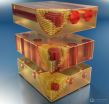(Press-News.org) Researchers at the University of Memphis and University of Pennsylvania report the development of robust new liver and fat cell models that report circadian clock function. These models are amenable to high throughput drug screening and could be used to find promising small molecules to resynchronize or help body clocks function normally. The consequences of modern life, eating and staying up later, shift work, cell phone addiction, and travel across time zones, all disturb internal clocks. These clocks are found in the brain where they regulate sleep, and also throughout the body, where they regulate much of our physiology and metabolism. Disrupting these clocks is called circadian misalignment which has been linked to metabolic problems even in healthy volunteers. These new cellular clock models could help scientists find new drugs that reset or help restore robust rhythms to metabolic clocks. The study, Ramanathan et al., is published in the current issue of PLOS Genetics.
The scientists started with metabolically relevant cells – hepatocytes and adipocytes –representing major functions of the liver and adipose tissues, and thus important aspects of the body's energy processing and storing system. Then they genetically engineered them to flash light with a daily rhythm much like an alarm clock. They validated the cell models and showed that changing clock gene function in these cells is similar to what happens in mice lacking clock genes. "We are very excited about the prospect of using these more physiologically relevant cell-based models for gene and small molecule drug discoveries," says Dr. Andrew Liu, Assistant Professor of Biology at the University of Memphis.
These cellular clock models allow monitoring of molecular rhythms using inexpensive off-the-shelf recording devices, making it suitable for basic research laboratories, as well as large-scale screens in pharmaceutical companies. "The previous cellular models were great," says John Hogenesch, Professor of Pharmacology at the University of Pennsylvania Perelman School of Medicine, "but they needed high end imaging equipment that is out of reach for most labs and early stage startups." By expanding the number of labs that can do these studies, these models could catalyze better understanding of peripheral clocks as well as new genetic and chemical tools to improve their function.
INFORMATION: END
Development of new cell models that report circadian clock function
2014-04-11
ELSE PRESS RELEASES FROM THIS DATE:
Devil in disguise: A small coral-eating worm may mean big trouble for reefs
2014-04-11
New research from the University of Southampton has identified a coral-eating flatworm as a potential threat for coral reefs.
It is barely possible to see the parasitic worm Amakusaplana acroporae when it sits on its favourite hosts, the staghorn coral Acropora, thanks to its excellent camouflage. However, the researchers found that the small flatworm could cause significant damage to coral reefs.
The scientists from the University of Southampton, who are based at the Coral Reef Laboratory in the National Oceanography Centre, Southampton, published the results of ...
Brain cell discovery could open doors to targeted cancer therapies
2014-04-11
Fresh insights into the processes that control brain cell production could pave the way for treatments for brain cancer and other brain-related disorders.
Scientists have gained new understanding of the role played by a key molecule that controls how and when nerve and brain cells are formed – a process that allows the brain to develop and keeps it healthy. Their findings could help explain what happens when cell production goes out of control, which is a fundamental characteristic of many diseases including cancer.
Researchers have focused on a RNA molecule, known ...
How nerve cells flexibly adapt to acoustic signals
2014-04-11
Researchers at Ludwig-Maximilians-Universitaet (LMU) in Munich have shown how nerve cells flexibly adapt to acoustic signals: Depending on the input signal, neurons generate action potentials either near or far away from the cell body. This flexibility improves our ability to localize sound sources.
In order to process acoustic information with high temporal fidelity, nerve cells may flexibly adapt their mode of operation according to the situation. At low input frequencies, they generate most outgoing action potentials close to the cell body. Following inhibitory or ...
Study resolves controversy over nitrogen's ocean 'exit strategies'
2014-04-11
A decades-long debate over how nitrogen is removed from the ocean may now be settled by new findings from researchers at Princeton University and their collaborators at the University of Washington.
The debate centers on how nitrogen — one of the most important food sources for ocean life and a controller of atmospheric carbon dioxide — becomes converted to a form that can exit the ocean and return to the atmosphere where it is reused in the global nitrogen cycle.
Researchers have argued over which of two nitrogen-removal mechanisms, denitrification and anammox, is ...
Forging iron women
2014-04-11
Published in the Journal of Nutrition, researchers undertook a systematic review and analysis of the effect of iron supplementation to the exercise performance of women aged from .
Lead researcher, Dr Sant-Rayn Pasricha from the Melbourne School of Population and Global Health found that iron supplementation improved women's exercise performance, in terms of both the highest level they could achieve at 100% exertion (maximal capacity) and their exercise efficiency at a submaximal exertion. Women who were given iron were able to perform a given exercise using a lower ...
Eye of the beholder -- improving the human-robot connection
2014-04-11
Researchers are programming robots to communicate with people using human-like body language and cues, an important step toward bringing robots into homes.
Researchers at the University of British Columbia enlisted the help of a human-friendly robot named Charlie to study the simple task of handing an object to a person. Past research has shown that people have difficulty figuring out when to reach out and take an object from a robot because robots fail to provide appropriate nonverbal cues.
"We hand things to other people multiple times a day and we do it seamlessly," ...
Greenland ice cores show industrial record of acid rain, success of US Clean Air Act
2014-04-11
The rise and fall of acid rain is a global experiment whose results are preserved in the geologic record.
By analyzing samples from the Greenland ice sheet, University of Washington atmospheric scientists found clear evidence of the U.S. Clean Air Act. They also discovered a link between air acidity and how nitrogen is preserved in layers of snow, according to a paper published this week in the Proceedings of the National Academy of Sciences.
Forty-five years ago, acid rain was killing fish and dissolving stone monuments on the East Coast. Air pollution rose beginning ...
Researchers develop ErSb nanostructures with applications in infrared and terahertz ranges
2014-04-11
In a feat that may provide a promising array of applications, from energy efficiency to telecommunications to enhanced imaging, researchers at UC Santa Barbara have created a compound semiconductor of nearly perfect quality with embedded nanostructures containing ordered lines of atoms that can manipulate light energy in the mid-infrared range. More efficient solar cells, less risky and higher resolution biological imaging, and the ability to transmit massive amounts of data at higher speeds are only a few applications that this unique semiconductor will be able to support.
"This ...
The taming of the shrew
2014-04-11
The Borna disease – named after the German city of Borna, which saw a cluster of cases over 100 years ago – mainly affects horses and sheep, and in rare cases cattle and rabbits too. A single case of an infected dog has been reported. Affected horses seclude themselves from the herd and suffer from depression and general disorientation. Ultimately, this incurable infection is fatal.
Borna virus detected in bicoloured shrews
Researchers have long been in the dark concerning the transmission mechanism of the Borna virus. The bicoloured shrew was one suspect, but definitive ...
Nobel prize candidates wait often over 20 years to win their prize
2014-04-11
Candidates for a Nobel prize often have to wait more than 20 years to receive this highest of scientific accolades. According to a Correspondence by Santo Fortunato of Aalto University in Finland and colleagues, such nail-biting delays are becoming the norm — to the point that aspiring laureates may themselves have expired by the time the medal is due to be presented.
Before 1940, Nobel prizes were awarded more than 20 years after the original discovery for only about 11%, 15% and 24% of physics, chemistry and physiology or medicine prizes, respectively. But by 1985, ...



